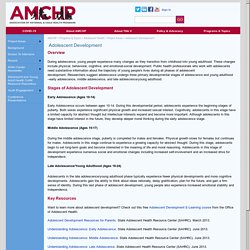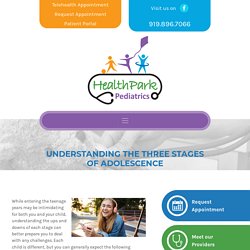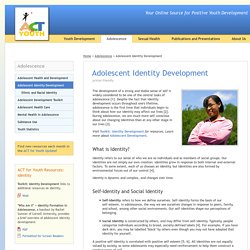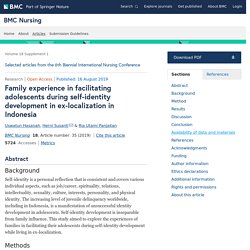

Adolescent Development. Overview During adolescence, young people experience many changes as they transition from childhood into young adulthood.

These changes include physical, behavioral, cognitive, and emotional-social development. Public health professionals who work with adolescents need substantive information about the trajectory of young people's lives during all phases of adolescent development. Understanding the Three Stages of Adolescence - HealthPark Pediatrics. While entering the teenage years may be intimidating for both you and your child, understanding the ups and downs of each stage can better prepare you to deal with any challenges.

Each child is different, but you can generally expect the following changes during the three stages of adolescence as outlined by the American Academy of Pediatrics. Each stage is separated into lists of both physical and mental/emotional changes. Ages 10 to 13: Early Adolescence Physical Growth & Development Puberty for many children and pre-teens begins during this stage of adolescence.Pre-teens experience both physical growth and sexual development, which can be uncomfortable for pre-teens and teens.Body changes during early adolescence may include developing hair under the arms and in the pubic area, testicular enlargement in males, and breast development in females.Changes usually start happening earlier for females than for males.
Adolescent Identity Development - Adolescence - ACT for Youth. The development of a strong and stable sense of self is widely considered to be one of the central tasks of adolescence [1].

Despite the fact that identity development occurs throughout one's lifetime, adolescence is the first time that individuals begin to think about how our identity may affect our lives [2]. During adolescence, we are much more self-conscious about our changing identities than at any other stage in our lives [3]. Visit Toolkit: Identity Development for resources. Adolescent Psychosocial Development. Family Experience in Facilitating Adolescents During Self-Identity Development. Identity achievement of adolescents living in ex-localization is similar to that of adolescents in general In this study, the families expressed that the identity achievements of their children in terms of changes were similar to the achievements of adolescents in general.

These changes included physical, appearance, and behavioral changes, the ability to build relationships with members of the opposite sex, and the ability to choose activities based on their own interests. Brownlee [14] states that development in early adolescence is characterized by rapid physical changes including height, maturity of reproductive organs, secondary sex characteristics, increased muscle strength, and weight [15, 16]. The biological changes are signs of maturity, such as the functioning of reproductive organs (menstruation in females and nocturnal emissions in males), as the adolescents are moving toward adulthood. External barriers were dominant during identity achievement. A Formulation of Erikson's Theory of Ego. What is Ego Identity? The Extremes of Ego Identity. Marcia’s Identity Theory. Marcia's Identity Statuses. Erik Erikson’s Identity Crisis: Who am I? Identity vs. Role Confusion.
Implications of Identity vs Role Confusion. Self Identity: Theory & Definition. Adolescence Crash Course.